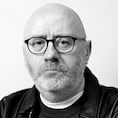We are at the Venice Film Festival in early September. Colin Farrell and Brendan Gleeson are enjoying views of the Adriatic in an Excelsior Hotel teeming with celebrities. Normality has, however, not fully returned. The day before we meet, I am required to take a Covid test. This means we can shake hands. While doing so, I apologise for the visible mosquito bites that habitually decorate visitors to Venice who’ve been too sparing with the insect repellent.
“Not monkeypox, then?” Farrell says, laughing.
They seems happy. Why wouldn’t they be? The premiere of Martin McDonagh’s The Banshees of Inisherin is not for another few hours, but it is already clear the film is going down a storm. Later in the day, those maniacs tabulating the length of standing ovations will decide it has broken this year’s record. There is barely a dissenter among the critics. A week after we meet, Farrell will win the Copa Volpi for best actor. This feels like a landmark moment for a performer who has been managing his career like a master for the last two decades.
[ Colin Farrell wins best actor at Venice International Film FestivalOpens in new window ]
“What have you liked so far? What have you hated?” Farrell asks.
Well, I’ve liked The Banshees of Inisherin. Farrell and Gleeson play a pair of friends on a western Irish island who, for no apparent reason, fall out as the Civil War rumbles analogously on the mainland. One day, the two are hunched over pint bottles of Guinness. The next, the older of the friends — Gleeson, of course — decides they can no longer share the same air.
I think we both had common purpose, common aspiration and common sensibilities — though we are very different people
Reuniting the lead actors with the director for the first time since In Bruges some 14 years ago, The Banshees of Inisherin moves away from the Midwestern gothic of McDonagh’s Oscar-winning Three Billboards Outside Ebbing Missouri back to the heightened hyper-Irishness of early plays such as The Beauty Queen of Leenane and The Cripple of Inishmaan (the title alone is a nod in those directions). I wonder aloud if audiences outside Irish communities will get the wider resonances.
“How do you mean?” Gleeson cuts in.
Well, it is presumably no accident that the personal falling-out is happening against the backdrop of the Civil War. Not every overseas viewer will be aware of that conflict.
“It’s all context,” Gleeson says. “You have this extraordinary, beautiful landscape — epically shot. And there’s this ‘Phumph! Phumph!’ going on in the background that we appear to be not unaffected by. That’s a context. Everything is concentrated on the personal war that happens on the island. One of the gratifying things for me is that it has actually travelled. There is no parochialism about how it is being viewed.”
Of course, this country is not alone in experiencing a traumatic historical schism. Few nations have escaped such disputes.
“You don’t have to look too far in most civilisations to find an echo,” Gleeson continues. “And Martin’s genius is to leave it as an echo. You get a reference to the executions. But it’s about the consequences of people falling out, and how that escalates.”
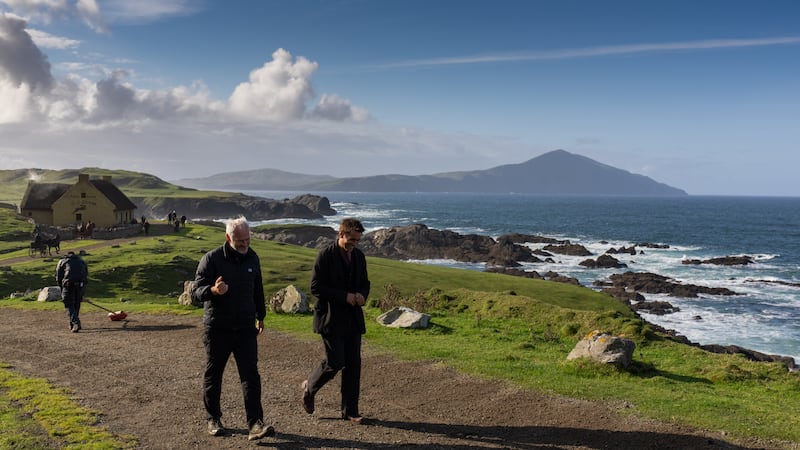
The two men form a perfect complement on both screen and in person. Gleeson is solid, furrowed and occasionally probing. We all know that he worked as a teacher before becoming a full-time actor in early middle-age and, every now and then, you feel as if you’re being good-naturedly quizzed on your homework. Farrell, as ever, is chatty, busy and perky as a puppy. I am mildly surprised that they don’t seem to have been asked — or not today, anyway — when they first met. It seems the first ever chat was connected with Gleeson’s long-cherished plan to make a film of Flann O’Brien’s greatest novel.
“It was in New York because I was trying to get At Swim-Two-Birds done,” he says.
“That’s right. At the Chelsea Hotel! He wrote a script for At Swim-Two-Birds,” Farrell says, swinging to me.
[ Colin Farrell’s canny journey from ‘hell-raiser’ to star of prestige cinemaOpens in new window ]
That project has become legendary. Gleeson will forgive us if we note almost certainly unreliable reports that Michael Fassbender, Gabriel Byrne, and Cillian Murphy were also circling the script at various points.
“You came close a few times,” Farrell says to his friend. “But the wind was just too strong in your face.”
“Anyway, we didn’t get it, but we just hit it off,” Gleeson says. “I found you amazing at the time. I remember you telling me that you’d been living in hotels for about seven years. We had a chat about that. I found it concerning and disarming, but we hit it off in a way that was fundamental. So when In Bruges came about, we hit a seam where I think we both had common purpose, common aspiration and common sensibilities — though we are very different people. That was a very satisfactory way to work.”
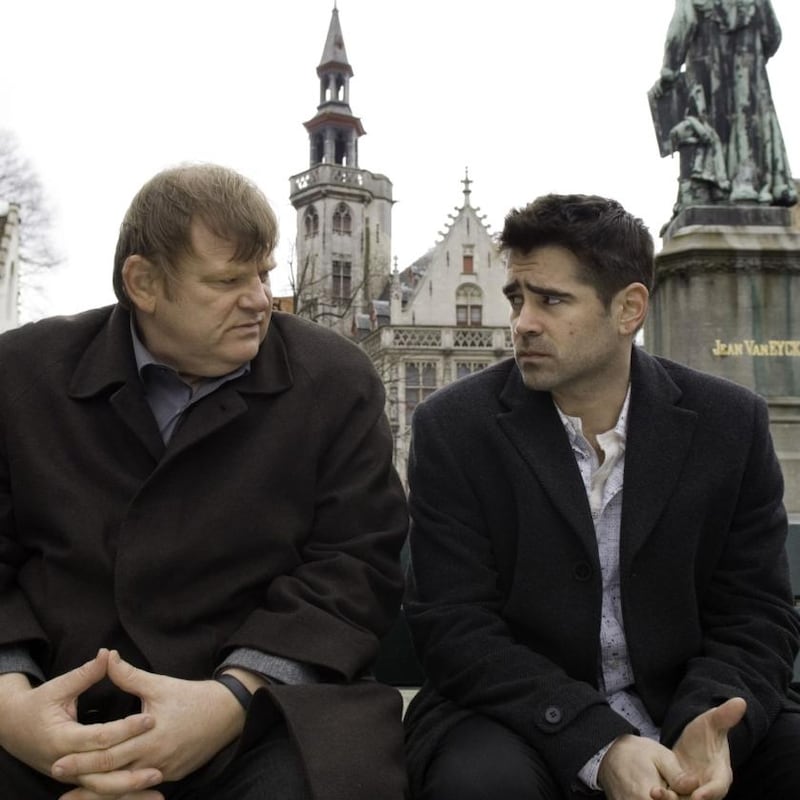
You can see the relationship at work in this interview. Obviously, Farrell does nothing so hierarchical as “defer” to Gleeson. That wouldn’t be his way. But there is an unmistakable sense of respect. The older man gently leads the conversation.
“There are people who like to promote discord, and they find that interesting,” Gleeson says. “I find that dull and unimaginative. You need people who have a collaborative, collegial ambition to get the most out of the work. I find that most thrilling. I knew he shared that. I knew Martin shared that. So it was a thrill to go back to work with them.”
Colin and I hit a seam where I think we both had common purpose, common aspiration and common sensibilities — though we are very different people. That was a very satisfactory way to work
Farrell joins in: “The thing about Brendan — as an artist, but more importantly as a man — is he’s able to protect and to share his opinions and his thoughts. But you never feel like he’s pushing a personal agenda. Right? You always feel like he’s being open. Any provocation that comes from him is borne of an openness to being changed. ‘This is my foundation. Come in and shake it.’ That is just so fertile.”
The Banshees of Inisherin showcases the work of not just two, but three generations of Irish acting. Gleeson was born in 1955, Farrell in 1976. Barry Keoghan, who plays a simple-minded young friend to Colin’s character, came into the world in 1992. (Kerry Condon, excellent as Farrell’s sister, sits somewhere between the last two.) The nation and the business have changed immeasurably in the last few decades.
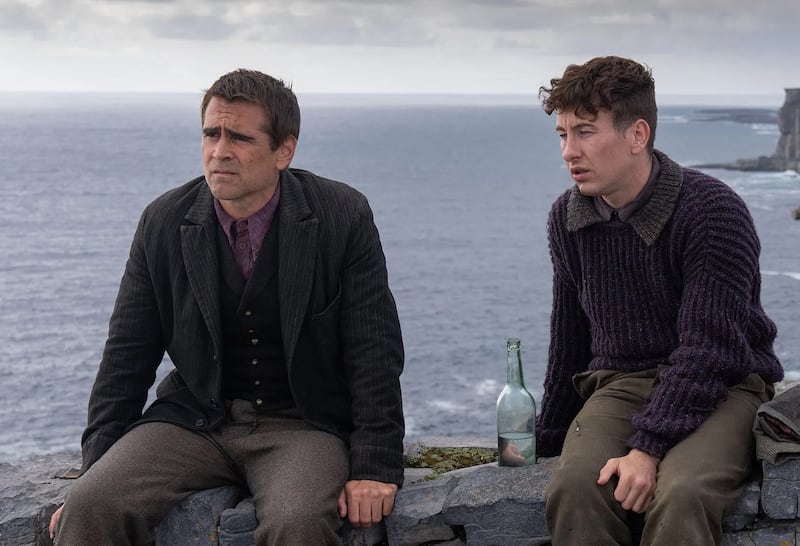
Initially a theatre actor with companies such as Passion Machine, Gleeson eased cautiously into the professional acting life. Farrell, raised largely in a middle-class corner of west Dublin, progressed to stardom via television success in Ballykissangel. There were fewer Irish movie stars about the place when Farrell began. There were many, many fewer when Gleeson first took on Hollywood roles. You had Liam Neeson and Gabriel Byrne. Keoghan now has a host of inspirations to draw on.
“I only know the path that I’ve walked,” Farrell says. “But I do know people came before, going back even to Maureen O’Hara to Barry Fitzgerald. There were obviously Gabriel and Liam. That made my path easier. A couple of actors have said my path made theirs a little easier. I know one thing. Barry Keoghan is a f**king miracle – that he’s still alive. Never mind that he’s doing the work he’s doing.”
Keoghan did, indeed, have a tough upbringing. He was born into the north inner city of Dublin during the height of the heroin epidemic. His mother died of an overdose when he was just a child, and he was passed on to foster homes. He gives a lot of credit for his survival to an inspirational grandmother. “The way I went through it really wasn’t nice,” Keoghan told me in 2018. “And that does make you a solid man. It makes you deal with things a lot better.” He went on to roles in Dunkirk, The Killing of a Sacred Deer and Eternals. He’s now the Joker, for goodness’ sake.
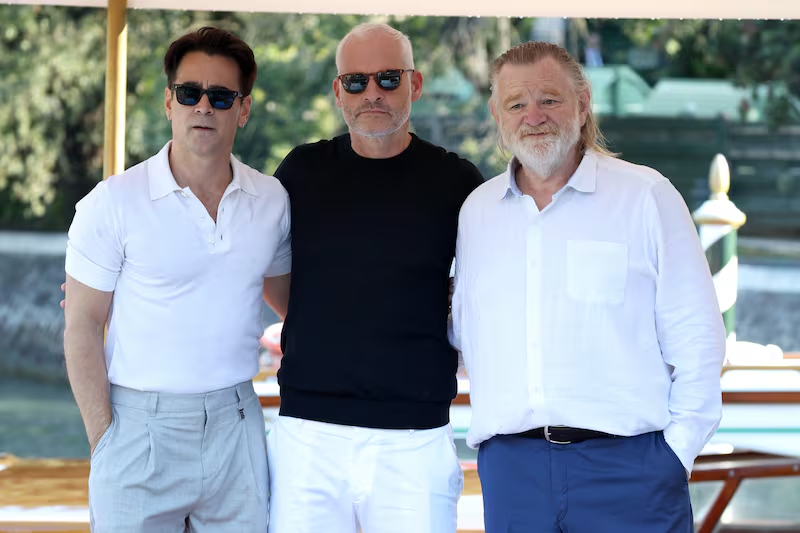
“He’s beautifully ambitious,” Farrell continues “I think I had a bit of shame around my ambition. Right? Look, I got on the fucking plane at Santry and flew over. Ha ha! I did the 6,000 miles. So I can’t wash my hands of how ambitious I was. I think ambition can be tainted. We can judge it very harshly. But I don’t think it’s a bad thing. The maturity with which Barry has stepped into his own ambition is incredible — and he just wants to do incredible work. He’s not averse to the bit of fame. He loves a bit of swag. He likes a nice fucking trip to the Dior shop or Gucci.”
“But that’s not all it is,” Gleeson interjects. “Oh, no. That’s a long way from all it is. He inhabits a space that’s incredibly pure. He really wants to do the work. It’s quite impressive.”
We know nothing of how the other man lives, but I am betting that Gleeson rarely enjoys a toodle round Gucci or Dior.
There was a lot of curbing of the natural instinct that happened for Irish actors in London. But there was a difference between our generation and Colin’s
Both Farrell and Keoghan had an eye on movie stardom from an early age. That must have seemed close to unattainable when Gleeson was winning plaudits at the Project Arts Centre in the 1980s.
“I would have taken inspiration from Gabriel, particularly,” Gleeson says. “And obviously Liam. But Gabriel is the one who proved that you could do it coming from a theatrical background. He was also a teacher for a couple of years. So there was that. He always had a kind of integrity. He didn’t lose himself in the maelstrom. I have admired him from the very beginning. ‘Why should we not go into this?’ He managed to dodge London. Previously, London was the only way to do it. There was a lot of curbing of the natural instinct that happened for Irish actors in London. But there was a difference between our generation and Colin’s. The bravery and the abandon you went with. That is a different kind of Irishman.”
Farrell chuckles politely. There was that. Later on, there was careful planning. Farrell notes that Keoghan is chasing “the Lanthimoses and the McDonaghs”. But it is to Farrell’s credit that, after an initial period of matinee idol success, he worked with not just Yorgos Lanthimos and Martin McDonagh, but also Michael Mann, Terrence Malick, Oliver Stone, Woody Allen, Sofia Coppola, Peter Weir, Neil Jordan, and on and on. There is a real sense of lessons being passed on through the generations.
“You were close to it, but Barry feels like the first for whom it was a completely cinematic approach,” Gleeson says to Farrell. “Theatre for you was still a thing. Barry was purely cinematic from the very beginning. That, for me, is the difference in terms of the generation we now have. We didn’t start off being cinematic.”
“It’s a natural progression from the pen to the camera,” Farrell says. “It’s just a question of how many generations it is going to take. It’s all storytelling.”
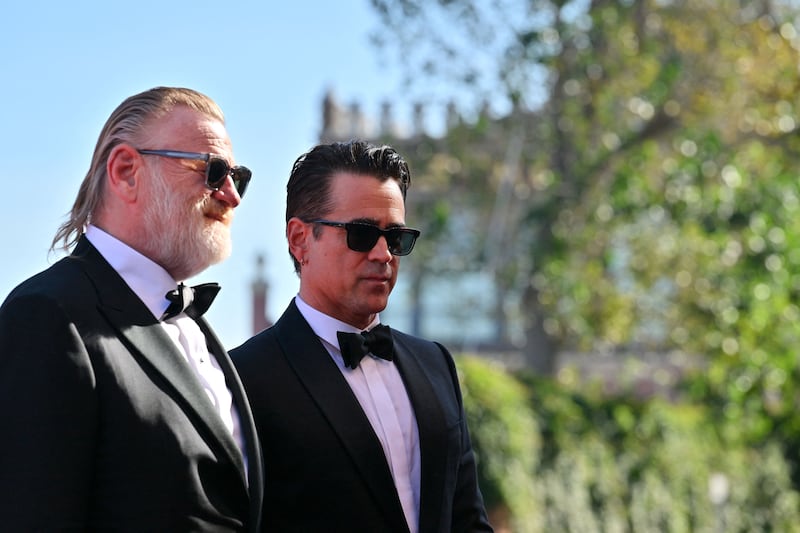
The three men find themselves in an interesting position with The Banshees of Inisherin. We were talking earlier about nuances that overseas viewers may miss. We can’t expect someone at the Reykjavik Ritzy to know about the Irish Civil War. No critic I’ve talked to in Venice has remarked on the fact that a trio of Dubliners are playing Connacht men. Kerry Condon, from Tipperary, was at least raised halfway across the island.
“I think we should all be cancelled!” Colin says, laughing.
“I was given a visa to Boyle in Roscommon when I was 19,” Gleeson joins in.
They play Americans and English people all the time, but I can see that causing some muttering.
“You think so? But why?” Gleeson asks.
Well, there is a largely good-natured tension between Dublin and the rest of the country. The narcissism of small differences comes to play in all nations.
“No, I think it is to do with power,” Gleeson says thoughtfully. “There is a resentment of the centralisation of power. I had an argument when I was very young — just prior to that green card success, ha ha! — where I asked about a particular politician. I said: ‘How can you guys vote for this guy?’ We knew he was one of those schmoozers. They said: ‘Do you think anybody in government gives a damn about us up there if he’s not out there shouting?’ This is 40 or 50 years ago.
“And I said: ‘Okay, I get it’. They feel unrepresented. My father was from the country. He was from Tipperary. It’s Paddy Kavanagh’s thing: ‘The gods made their own importance’. An epic happens in the way this film makes it happen — in the way that great writers make it happen. I am familiar with the country. The idea that there is a struggle between Dublin and country sensibilities is missing the point.”
He makes the argument that great writers are always “within and without”. McDonagh was, of course, raised by Irish parents in south London. Gleeson references an Englishman long resident in Ireland.
“John Boorman is within and without. Martin is within and without. The great writers are always there and outside. Being outside and in is almost a pre-requisite. For me, it was about going into an epic landscape with epic issues.”
If the 79th Venice Film Festival is nothing else, it marks another lunge forward for those interlocked generations of Irish performers. Farrell’s Volpi win — unable to return for the ceremony, he awarded himself a bunch of bananas during a video call from Los Angeles — has come close to nailing him down for a first Best Actor nomination at the Oscars. At the time of writing, Variety has Gleeson marked as favourite to win Best Supporting Actor (though Searchlight Pictures may still decide to pitch both men as leads).
Shaking that tree was starting to become unhealthy. I needed to go back to doing what I do. I have been doing that for 10 years. I said I’ll wait for the apple to fall
Here’s a thought. Should those predictions come to pass, it will surely be time to get out the At Swim-Two-Birds script. When did Gleeson last look at it?
“I honestly took it down for the first time in about ten years, on the plane coming over,” he says.
Farrell sounds genuinely excited. “How did it feel? What was it like?”
“I actually got really excited reading it,” Gleeson says, almost bashfully. “Shaking that tree was starting to become unhealthy. I needed to go back to doing what I do. I have been doing that for ten years. I said I’ll wait for the apple to fall. If it doesn’t fall, you have to go back to shaking the tree. But I got strangely excited on the plane. I thought: ‘You know, this isn’t bad’.”
We’ll all meet back for the Venice premiere in 2025 or so, then.
The Banshees of Inisherin opens on October 21st
